If I blink I might miss it. One moment our dive guide, Jimmy, is hunkering down among the boulders at Wolf Island’s Landslide dive site, sheltering from the current. The next moment he bolts into the blue and toward the limit of my visibility. I don’t see anything out there, but after two days in Galápagos, I am already a firm believer. I race into the flow, pumping my fins, swimming parallel with his track and straining my eyes. Suddenly the effort all makes sense — a giant is approaching.
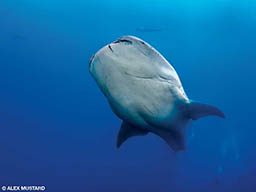
I had almost forgotten how big whale sharks can get; all my recent encounters in Asia and Mexico were with 20-foot youngsters. This female is ginormous, a conservative 45 to 50 feet long, while above her is a swirl of 8-foot scalloped hammerhead sharks, looking barely larger than remoras through my fisheye lens. I swim alongside the colossal shark, my legs burning with exertion, hoping to eke out as much time in her presence as I can.
With my lungs fit to burst, my sprinting fades as I watch the whale shark lazily swim off into the blue, and I head back to the drop-off. I settle back among the boulders to catch my breath and catch up with my buddies. Soon we’re treated to close passes by patrolling Galápagos sharks that look a lot like supersized Caribbean reef sharks. Beyond them a seemingly endless conveyor of hammerheads weave into view and then vaporize back into the hazy waters. It is a mesmerizing panorama.
Jimmy signals that time is up for this dive, and we swim out to the blue and perform our safety stop drifting below his surface marker buoy. Below us groups of hammerheads continue to materialize and vanish, and four young 5-foot silky sharks circle and inquisitively stare at us with their darting, feline eyes. We see three more whale sharks that day. Galápagos is truly living up to its reputation as the sharkiest place on the planet.
Small Islands, Big Ideas
Ecuador’s Galápagos Islands — an archipelago consisting of 13 main islands (five of which are inhabited), seven minor islands and more than 200 islets and rocks — sit about 600 miles off South America’s Pacific coast. Before they were the Galápagos, the islands were called Las Encantadas (meaning “enchanted” in Spanish) for the way they captured the imaginations of their visitors, most famously Charles Darwin.
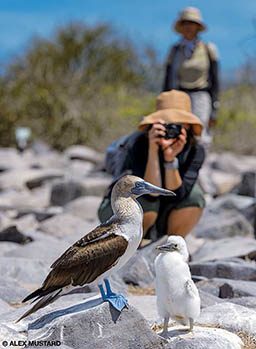
The harsh volcanic landscapes of the Galápagos host creatures found nowhere else on Earth. The archipelago’s remoteness and stark landscapes left it unclaimed and uncolonized for a long time, protecting its endemic species from human intervention. This serendipity, combined with the founding of the Galápagos National Park in 1959, means that a full 90 percent of the islands’ original biodiversity survives in what has become a natural time capsule.
The tough, arid conditions of the Galápagos Islands have shaped much of both their human history and natural history. Quite simply, these are difficult islands to settle: Where humans adapted strategies to manage the Galápagos’ environmental adversity, nature responded with biological adaptation over the generations. The islands support 7,000 species of flora and fauna, and an astonishing 97 percent of the reptiles and 80 percent of the land birds exist nowhere else on Earth. It is little wonder how a curious mind like Darwin’s was prompted to consider the origin of species after visiting the Galápagos.
While life on land for the creatures of the Galápagos may be difficult, these challenges do not extend under the surface. For ocean life, the archipelago is an Eden providing almost perfect conditions year-round for marine species to flourish with a magnitude and vitality few locations on the planet can match.
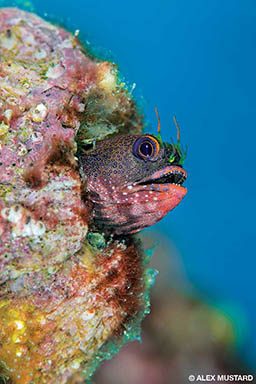
While the archipelago straddles the equator, the waters around Galápagos are not the picture-perfect crystal blue of the tropics because of the composition and location of the islands, which are actually the tips of a 3-mile-high volcanic ridge spiking precipitously from the ocean floor. Four major ocean currents converge and collide with this barrier, forcing fertile, deep ocean water to the surface. Here the water encounters high-octane tropical sunlight that sparks an explosion of phytoplankton and in turn supercharges the entire marine food chain. These nutritious waters are the reason that the seas of the Galápagos churn with fish, which in turn feed large populations of predators, including sharks, whales, dolphins and Galápagos sea lions in addition to the islands’ vast colonies of seabirds.
The archipelago’s swirl of currents also contributes to the area’s incongruous mix of microclimates, each of which provides habitats for a different set of species. These microclimates lead to the surprising juxtapositions of, for example, flamingos living beak to beak with penguins. For the diver, it makes packing a nightmare but the underwater spectacle a dream; on the surface we have to layer garments, but underwater we get a lifetime’s quota of world-class dive experiences on a single trip.
While the liveaboard experience provides the varied thrills of each new day’s totally distinctive underwater wonders, it cannot be overstated that Galápagos diving is often very challenging. Conditions are hard to predict: The water is regularly cold, visibility is poor, and strong currents are common, which can be particularly intimidating in such a remote, open ocean location. Many divers find the challenge addictive because it makes the rich rewards all the sweeter. For others, this is a bucket-list location about which they will tell tales on every future dive trip, but one they are content to leave unrepeated.
Cold Water, Cold Blood
How cold can the ocean be at the equator? The answer is surprising. Every diver has different tolerances to chilly water, but on the dives along the western edge of the archipelago, the ocean is cold enough that everyone on my trip feels it and complains, even if they never miss a beat before signing up for their next dives. Some members of my group have brought drysuits just for these dives, while others add heated vests; the rest of us beg and borrow every last piece of neoprene we can find on board. My computer says that this cold water from the Cromwell Current is 64˚F (18˚C), while Jimmy grins and says, “It’s warmer than usual.”
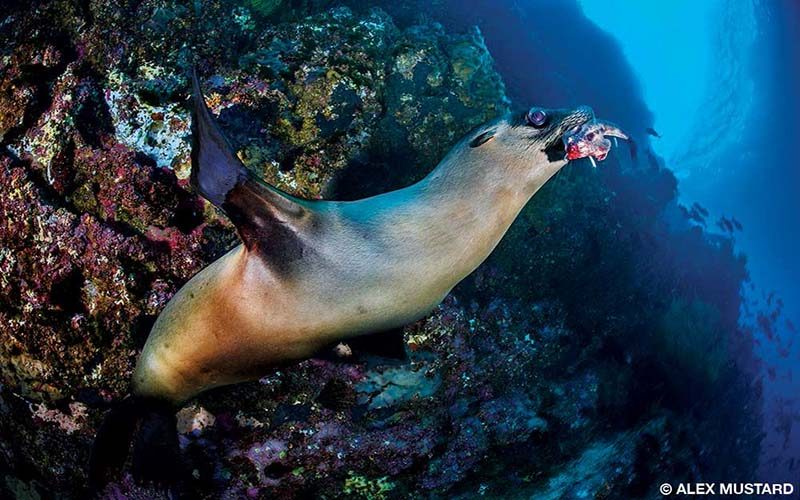
The cold water attracts different species. We delight in encounters with playful Galápagos sea lions, especially the effervescent youngsters racing back and forth along the drop-off at Punta Vicente Roca at Isabela Island. Charming mature females babysit the pups as they blow bubbles at each other and at us, providing such a heart-melting distraction that some of our group stay with them for the whole dive rather than head down to see the Mola mola at the cleaning station 100 feet below. These bizarre sunfish look almost inanimate as they wait for the attention of the school of Mexican hogfish that stay busy picking off parasites.
In the shallows, dozens of endemic Galápagos turtles gather to feed on algae. They are vegetarians like their cousins, the green turtle, but evolution has darkened their pigment to a deep khaki to help them absorb the sun’s warmth. The award for the most curious coloration goes to the harlequin hogfish, which is also specific to this region. The young wrasses are a drab gray, but as they mature each brightly colored organism develops a unique pattern, similar to those produced by selective breeding in domestic koi carp. We delight in seeing a large white individual with orange and black blotches, which would be called sanke in koi circles, chasing smaller fish around a pinnacle. Darwin, I am sure, would be fascinated by this confluence of the signs of artificial and natural selection.
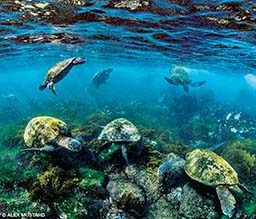
A streak of silvery bubbles flashes past, and as my eyes play catch-up I spy my first penguin underwater. Given the water temperature, perhaps I shouldn’t be so surprised by its appearance. The small penguin is so fast that I can’t pan my camera through the water quickly enough to keep it in frame. It swims with clockwork wing beats as it loops around and through a small school of baitfish, vanishing as suddenly as it appeared.
Our guides save the best of the cold water for last, when they take us to visit Cape Douglas on Fernandina Island to swim with marine iguanas. Descended from land iguanas that were carried to the island on driftwood and found nowhere else on Earth, these creatures provide a classic example of how the unusual Galápagan conditions of life have provoked unique evolutionary adaptations. Although the islands would have seemed like safety, the barren volcanic landscape provided little plant life for sustenance. Instead, the marine iguana’s ancestors turned to the rich ocean, learning to dive down and feast on the lush algae. While food is plentiful, the frigid water is a challenge for the cold-blooded reptiles, so they have evolved a black coloration that helps them heat up quickly both before and after diving. These miniature Godzillas dive with reptilian tenaciousness, gripping rocks as they chomp seaweed with their peglike teeth. They are not at all interested in us, but despite their single-mindedness, watching them is a major highlight for our group.
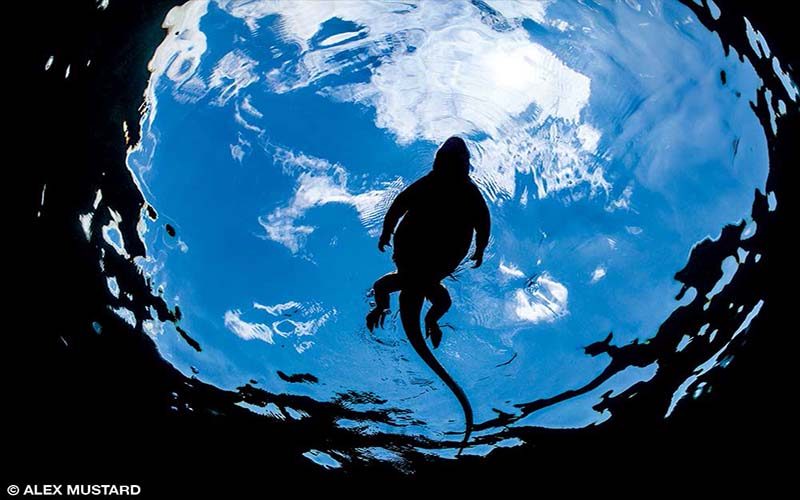
Lone Wolf and Darwin Islands
The Galápagos National Park carefully controls all diving to avoid overcrowding and protect the islands’ unique ecosystems. Boats get permission to be in certain places at certain times, and a boat cannot extend its stay, however good the diving is.
The Wolf and Darwin islands in the far north are what made the Galápagos famous with divers. An overnight steam over the horizon from the rest of the archipelago, the waters here are warmer and thick with life. Because nondiving tourists don’t visit here, the location always has a true frontier feeling. Most dive liveaboard trips to Galápagos therefore visit both Wolf and Darwin with longer itineraries, spending two days on each.
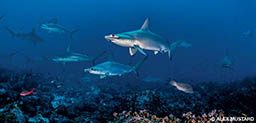
Most dives here involve hooking or clinging to the rocks while trying to hide from the current. Our guide usually chooses a spot near a prominent cleaning station, usually set up by barberfish (a yellow butterflyfish) or attractive king angelfish. There is no need for us to swim because the combination of cleaner fish and currents means that amazing marine life of all sizes parades past us until our dive computers beep that time is up.
Groupers, giant hawkfish and morays perch and poke out from between the boulders, while freeways of Pacific creolefish endlessly sweep past. Schools of bigeye trevally, bonitos, barracuda and tuna pitch up from time to time, sometimes in huge numbers. Then there are the big boys: Turtles are so numerous we start to ignore them, and eagle rays give close passes as they soar on the currents; sharks, particularly hammerheads, swarm in large numbers here and throughout the entire archipelago. Sometimes they come close enough for pictures; sometimes they stay frustratingly out of reach of my wide-angle lens, at the limit of visibility. But it is always completely captivating to watch their distinctive rocking movements as they sweep past or swoop in to be cleaned. Many have scars and scratches — it must be a tough life being a hammerhead.
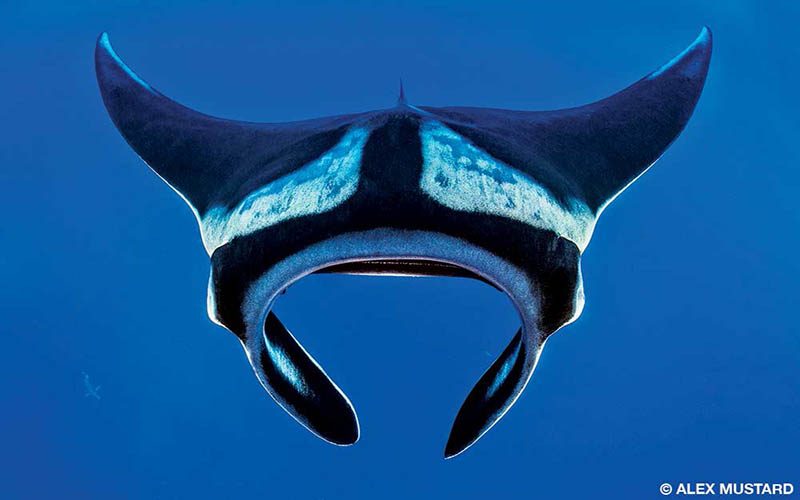
A large pod of bottlenose dolphins is resident at Wolf Island, and we are lucky see them a few times, their whistles signaling their arrival. Darwin Island is also a celebrated cetacean migration waypoint where world-class encounters are always possible. The common appearance of the unexpected is a key part of the DNA of Galápagos diving, and it means that every dive trip here is unique. When you compare notes with other divers, they will all have tales of that once-in-a-lifetime dive that is at once totally different from and as equally amazing as yours — just another reason that diving in the Galápagos is so addictive.
Epilogue
As a traveling scuba diver, I cannot avoid evidence that the oceans are in trouble. So many destinations lack sharks and other great creatures. Even on some of the most vibrant reefs we can be left wondering where all the big fish have gone. As little as a decade ago I’d rarely see plastic on my dives, but this is no longer the case. Diving the Galápagos refreshes the soul. Seeing the ocean as nature intended it — unpolluted and packed with life — is enriching and inspiring. The dives are white-knuckle rides, but you surface exhilarated and fulfilled, ready to ride again. This is the ocean as it should be; this is diving turned up to 11.
How to Dive It
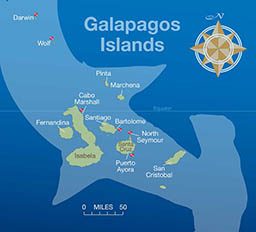
Getting there: No international flights fly directly into Galápagos; instead you must fly through one of Ecuador’s airports in Quito or Guayaquil. These are easy to reach internationally, but schedules usually require an overnight layover outbound. The best diving can be accessed only by liveaboard. Ecuador uses the U.S. dollar as currency. All visitors to the Galápagos must pay a $100 park fee and a $25 transit card fee.
Conditions: Conditions are variable, unpredictable and challenging. Prepare for strong currents, surge, limited visibility and water temperatures that vary from the low 60s°F to the 80s°F. Bring a reef hook, tough diving gloves and a large surface marker buoy and reel to deploy from your safety stop. Many divers choose to bring whistles, horns and even personal locator GPS beacons to help the boat quickly find them if drifting at surface. Because of the tricky conditions, it is important to stay with your guide.
Topside: All dive liveaboards include a few land tours, and photographers should bring a telephoto lens for the amazing opportunities. Many people choose to arrive a few days early or book an additional weeklong land-tour liveaboard to allow for more topside sightseeing.
| © Alert Diver — Q4 2018 |
|---|
| © Alert Diver — Q4 2018 |